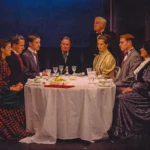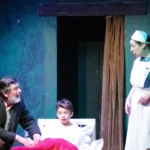Table of Contents
Theatre in a Barn
From Brickwall to Handside
A summary by Denys & Marion Wells, Barn Theatre Archivists for many years.
Several people have written accounts of the history of the Barn Theatre at Handside Lane, Welwyn Garden City, Hertfordshire since it was founded in 1932, and we are particularly grateful to Harry Stull for his detailed research, which has been invaluable to us.
Introduction
In 1832 the Horn family became tenants of the Panshanger estate (Earl Cowper) at Handside Farm, and continued to farm in the area for nearly ninety years. In about 1830 a new farmhouse had been built at Lower Handside, and the Handside Barn had been erected on its present site, next to the farmhouse [which is now one of the Barnside Court buildings]: the barn (possibly formerly two barns) is said to have been moved from nearby, and to have been first built much earlier.
By the end of the Great War the Horn family farmed both Handside and Brickwall, some 640 acres. In 1919 their land became part of the new town of Welwyn Garden City, and shortly afterwards the Handside farm was taken-over by the New Town Agricultural Guild, and the barn was used as a milking parlour and dairy (the farmhouse was extended to form the New Town Hostel.
The dairy farm closed in 1926, but the rear part of the barn continued to be used as the bottling plant for the Welwyn Stores, until the late 1930’s. The concrete silo was added to the barn early in this period, probably about 1921.
Early Theatre in Welwyn Garden City
Building of Welwyn Garden City started in 1920, and within a year, with the population less than 800, the first play was staged at Brickwall Barn (the Handside Barn was then full of cows!), when C.B. Purdom, a Director of Welwyn Garden City Limited (the company formed to build and run the town), and an enthusiast for all forms of drama, directed local people in Shaw’s ‘The Showing Up of Blanco Posnet‘. Drama proved to be a popular activity, and many groups were set up in the following years. Some key events with relevance to the subsequent opening of the Handside Barn as a theatre are listed below.
1921 Purdom founded the Welwyn Garden City Theatre Society, one of its objects being to seek a permanent theatre for amateur drama. Their first production was Shaw’s ‘Candida’, in the Cherry Tree Restaurant, in December.
1924 The Labour Players was founded, by F.J. Osborn and others, to perform plays of social interest (the following year the name was changed to Welwyn Folk Players). Their first play was ‘The White Lady’, by H.B. Pointing, a local author, presented in the Parkway Hall [where the east end of Rosanne House now stands] in March.
1928 The Welwyn Theatre (later the Embassy cinema) opened in Parkway [where the Health Authority building now stands] for use as both cinema and theatre. Apart from the Welwyn Drama Festival, which was held there with great success annually from 1929–1973, it was not very suitable for amateur drama, so the need for a small amateur theatre remained.
1929 The Welwyn Thalians were formed from the W.G. City Barnstormers (founded in 1923) and the W.G. City Operatic Society (founded in 1927), with a strong emphasis on musical productions.
During the period 1921–1931 the above drama groups, and others, regularly staged about six to eight shows each year, mostly in the Parkway Hall, and later in the Welwyn Theatre. In 1930 the Welwyn Stores Staff Association performed ‘Tilly of Bloomsbury‘, by Ian Hay, at the Handside Barn, which then housed their social club.
Growing dissatisfaction with the Welwyn Theatre led Dr L.T.M. Gray, a Director of the Welwyn Garden City Company (which owned the Handside Barn), who was also Chairman of the Theatre Society, to arrange, and to finance from his own resources, the conversion of part of the Barn to a theatre. All the local drama groups co-operated with the Theatre Society to carry out the necessary work, and the Barn Theatre was eventually inaugurated as a public theatre in January 1932, with Dr Gray as licensee, and responsible for its operation. It could seat 150 people on tip-up seats, with tickets at 1/3d [6 pence] and 2/6d [12 pence].
The Barn Theatre, Welwyn Garden City 1932 – 1940
The local press records the opening of the Barn Theatre on Monday 4th January 1932, with the four drama groups most involved in its preparation each performing a one-act play, with performances every night of the week:
- Folk Players 'The Invisible Duke', by F. Sladen-Smith
- Welwyn Stores DS 'The Fur Coat', by F.J. Talbol.
- Welwyn Thalians The Devil among the Skins', by E. Goodwin.
- Theatre Society 'The Leading Lady', by H.B. Pointing.
The first full-length production was of Shaw’s ‘Misalliance’, staged by the Theatre Society: in that opening year there were ‘only’ 5 full-length shows, compared with 10 in 1933!
In 1934 the first attempt was made to combine the main drama groups, to take over the running of the theatre. Not all of them agreed, but the Welwyn Drama Club was formed from the Theatre Society and a section of the Thalians, and took over management of the Barn where about five shows were staged each year, until it had to close down in 1940 after being requisitioned by the Army. Flora Robson, by now a talented and established professional actress, was the honorary President of the Drama Club from its foundation until its incorporation into the Barn Theatre Club in 1969 (she continued as Patron of the latter club until her death in 1984), and was able to attend a few productions at the Barn Theatre.
During the war years only the Folk Players, of the main groups, was able to continue with public productions, and they put on at least one full-length show, at St. Francis Church Hall, each year from 1941–1946.




